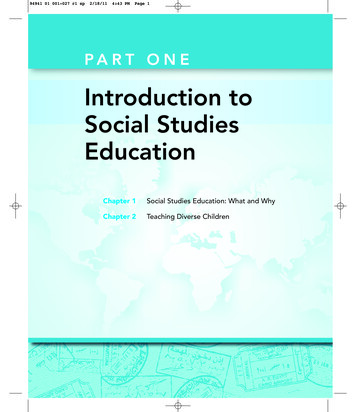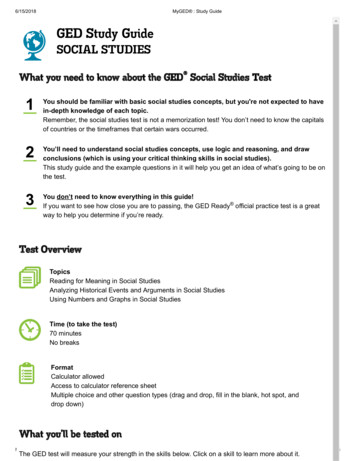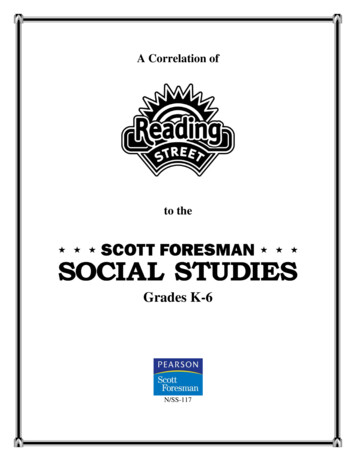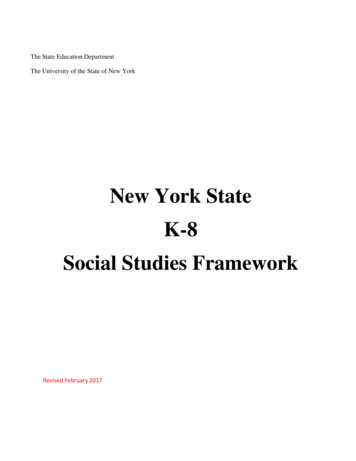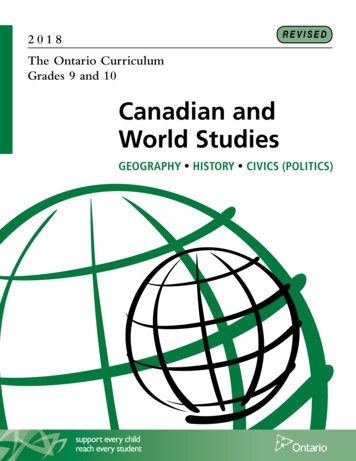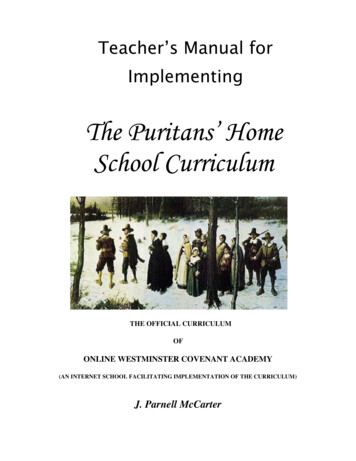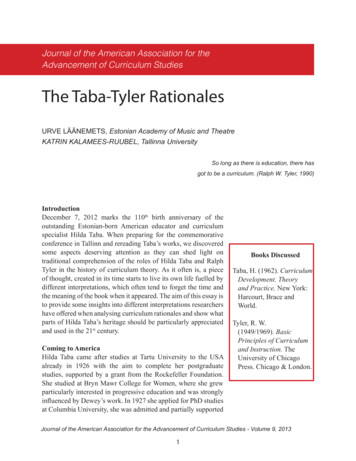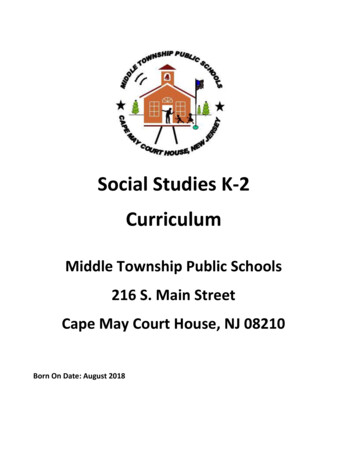
Transcription
Social Studies K-2CurriculumMiddle Township Public Schools216 S. Main StreetCape May Court House, NJ 08210Born On Date: August 2018
Middle Township Public SchoolsSocial Studies Curriculum GradesK-2
Goals of the Social Studies Curriculum Acquire a basic understanding and appreciation of American traditions and valuesbased on knowledge of history and of the development and functioning of theAmerican constitutional system of government; Develop critical thinking skills which enable them to function as lifelong learnersand to examine and evaluate issues of importance to all Americans; Acquire basic literacy in the core disciplines of social studies and have the basicunderstandings needed to apply this knowledge to their lives as citizens; Understand world history as the context for United States history and as a recordof the great civilizations and cultures of the past and present; and Participate in activities that enhance the common good and increase the generalwelfare.
K-2CurriculumFramework
Middle Township Middle School Social Studies CurriculumGrade Level and Content:Interdisciplinary ConnectionsK-5 Social Studies Academic and Technical Rigor - Projects are designed toaddress key learning standards identified by the school or district. Authenticity - Projects use a real world context (e.g.,community and workplace problems) and address issues thatmatter to the students. Applied Learning - Projects engage students in solving problemscalling for competencies expected in high- performance workorganizations (e.g.,teamwork, problem- solving, communication,etc.). Active Exploration - Projects extend beyond the classroom , andcommunity explorations. Adult Connections - Projects connect students with adultmentors and coaches from the wider community. Assessment Practices - Projects involve students in regular,performance-based exhibitions and assessments of their work;evaluation criteria reflect personal, school, and real- worldstandards of performance.Core Instructional MaterialsListed within individual curriculums and weekly lesson plansAssessmentsLiteracy and Math STAR, PARCCListed within individual curriculums and weekly lesson plansModifications for Special Education StudentsNote IEP, audio recordings, digital media, screen casts,visual presentationModifications for English Language LearnersExtended time, assign preferential seating, positivereinforcement, peer tutoring, study guides, lower readinglevel, read directions aloud, alternative assignmentsModifications for Students Who Lack SupportExtended time, assign preferential seating, positivefor Schoolreinforcement, peer tutoring, study guides, lower readinglevel, read directions aloud, alternative assignmentsModifications for Gifted StudentsIntegrate, abstract, complex and varied assignments,freedom of choice when applicable, variable pacing levels
21st Century SkillsCreativity & InnovationCritical ThinkingCommunicationCollaborationLife & Career SkillsInformation LiteracyMedia LiteracyChronological ThinkingSpatial ThinkingPresentational SkillsProblem SolvingDecision MakingTechnology Operations & Concepts Interdisciplinary Connections English Language Arts Science Technology Theater Character EducationCareer Ready Practices:CRP1. Act as a responsible and contributing citizen and employeeCRP2. Apply appropriate academic and technical skillsCRP3. Attend to personal health and financial well-beingCRP4. Communicate clearly and effectively with reasonCRP5. Consider the environmental, social and economic impacts of decisionsCRP6. Demonstrate creativity and innovationCRP7. Employ valid and reliable research strategiesCRP8. Utilize critical thinking to make sense of problems and persevere in solving themCRP9. Model integrity, ethical leadership, and effective managementCRP10. Plan education and career paths aligned to personal goalsCRP11. Use technology to enhance productivityCRP12. Work productively in teams while using cultural global competence
KindergartenGetting Along in OurCommunity OurGlobal CommunityOur Environment and Its Geography
Kindergarten Social Studies Scope and SequenceUnitMonthsEstimated PacingUnit 1: Getting Along in OurCommunitySeptember- December30 daysUnit 2: The Global CommunityDecember - March31 daysUnit 3: Our Environment andIts GeographyApril - June30 days
KindergartenUnit 1Getting Along In Our Community
Content Area:Social StudiesUnit Plan Title:Our Global CommunityUnit Topics:Citizenship begins with becoming a contributing member of the classroom community.Grade(s) KStandard(s) Number and Description (Established Goals)Standards:6.1 U.S. History: America in the World – All students will acquire the knowledge and skills to think analytically about how past and present interactions of people, cultures, and theenvironment shape the American heritage. Such knowledge and skills enable students to make informed decisions that reflect fundamental rights and core democratic values as productivecitizens in local, national, and global communities.6.1.4.A.1 Explain how rules and laws created by community, state, and national governments protect the rights of people, help resolve conflicts, and promote the common good.6.1.4.A.7 Explain how the United States functions as a representative democracy, and describe the roles of elected representatives and how they interact with citizens at local, state, andnational levels.6.1.4.A.8 Compare and contrast how government functions at the community, county, state, and national levels, the services provided, and the impact of policy decisions made at each level.6.1.4.A.10 Describe how the actions of Dr. Martin Luther King, Jr., and other civil rights leaders served as catalysts for social change and inspired social activism in subsequent generations.6.1.4.A.11 Explain how the fundamental rights of the individual and the common good of the country depend upon all citizens exercising their civic responsibilities at the community, state,national, and global levels.6.1.4.A.14 Describe how the world is divided into many nations that have their own governments, languages, customs, and laws.6.1.4.A.15 Explain how and why it is important that people from diverse cultures collaborate to find solutions to community, state, national, and global challenges.6.3 Active Citizenship in the 21st Century – All students will acquire the skills needed to be active, informed citizens who value diversity and promote cultural understanding by workingcollaboratively to address the challenges that are inherent in living in an interconnected world.6.3.4.A.1 – Evaluate what makes a good rule or law.6.3.4.A.2 – Contact local officials and community members to acquire information and/or discuss local issues.New Jersey Student Learning Standards:Reading Standards for Informational Text:RI.K.1 With prompting and support, ask and answer questions about key details in a text (e.g., who, what, where, when, why, how).RI.K.2 With prompting and support, identify the main topic and retell key details of a text. RI.K.4 With prompting and support, ask and answer questions about unknown words in a text.RI.K.7 With prompting and support, describe the relationship between illustrations and the text in which they appear.RI.K.10 Actively engage in group reading activities with purpose and understanding.Writing Standards:W.K.8 With guidance and support from adults, recall information from experiences or gather information from provided sources to answer a question.Enduring Understandings: Enduring Understandings: Everyone is part of larger neighborhood and community.Individuals and families have unique characteristics.There are many different cultures within the classroom and community.All family members have specific roles and unique characteristics.We all have a place in our family, school, and community.The Pledge of Allegiance is a promise that we make as citizens.School is where we learn things.
Children and adults at school have different roles and jobs in a community.People are alike in many ways, but are also different.There are leaders at home and at school and a community.Rules are important in the classroom, school, home and community.There is a need for fairness and we must speak up against unfairness.Students willIdentify roles of children and adults in the family Recite the Pledge of AllegianceIdentify things that are learned at school and community Identify roles of children and adults at school community Identify ways that people are alike and differentIdentify areas and jobs in a school/community Identify what leaders do at home and school Identify rules at home and schoolExplain why people need rulesExplain that a responsibility is a duty and give examples Follow three steps to resolve a conflictFind their classroom and other important places in the building on a map of the schoolEssential QuestionsWhat are rules and why do we need them?What is fairness?How can I make my classroom a better place?How should I treat others?How are we the same and how are we different?Student Learning Activities/Assessments: Draw a picture of the family traditionRole play a scene where a family works togetherCreate a family narrativeDiscuss familiesRecite the Pledge of AllegianceRole play greetings at the beginning and end of the school dayMake a book of school jobsDraw a picture of a classroom ruleDiscuss the basic things people need to live; place, clothes, food, water, talk about why they are important andhow adults provide themTeacher observation / classroom discussion / student participationMake a picture of a job chart for school and homeName rules for riding on the bus, riding in the car, and walkingMorning meeting activities
Technology Resources Books about family, home and schoolBooks about rules, community and culturesSuggested Read Alouds: Miss Bindergarten Gets Ready for Kindergarten by Joseph SlateDavid Goes to School by David ShannonTalk and Work It Out by Cheri J. Meiners, M.Ed.It’s Okay to be Different by Todd ParrJobs People Do by Christopher MaynardScholastic NewsReading A-Z Leveled Books (for Read-Alouds) Busy at School (Level C)Are You Okay? (Level F)It Is School Time (Level B)Jobs we do at School (Level E)Katie and Katie (Level D)I’m the Tall One (Level J)NJ Department of Education Website www.state.nj.us/educationReadworks.org People in CommunitiesWhat is a Good Citizen?Jon Follows School RulesTechnology Resources – United Streaming/Learn 360 (if os/grade 13/road-safety-and-traffic-rules-fo r-kids (7 minute video on road .bensguide.gpo.gov/www.youtubeKids for Character: CitizenshipOfficer Buckle and Gloria by Peggy Rathman
KindergartenUnit 2Our Global Community
Content Area:Social StudiesUnit Plan Title:Our Global CommunityUnit Goal:There are many different cultures within the classroom, community, and world.Grade(s) KStandard(s) Number and Description (Established Goals)Standards:6.1 U.S. History: America in the World – All students will acquire the knowledge and skills to think analytically about how past and present interactions of people, cultures, and theenvironment shape the American heritage. Such knowledge and skills enable students to make informed decisions that reflect fundamental rights and core democratic values as productivecitizens in local, national, and global communities.6.1.4.D.11 Determine how local and state communities have changed over time, and explain the reasons for changes.6.1.4.D.13 Describe how culture is expressed through and influenced by the behavior of people.6.1.4.D.20 Describe why it is important to understand the perspectives of other cultures in an interconnected world.6.3 Active Citizenship in the 21st Century – All students will acquire the skills needed to be active, informed citizens who value diversity and promote cultural understanding by workingcollaboratively to address the challenges that are inherent in living in an interconnected world.6.3.4.D.1 – Identify actions that are unfair or discriminatory, such as bullying, and propose solutions to address such actions.New Jersey Student Learning Standards:Reading Standards for Informational Text:RI.K.3 With prompting and support, describe the connection between two individuals, events, ideas or pieces of information in a text.RI.K.4 With prompting and support, ask and answer questions about unknown words in a text.RI.K.7 With prompting and support, describe the relationship between illustrations and the text in which they appear.RI.K.10 Actively engage in group reading activities with purpose and understanding.Writing Standards:W.K.8With guidance and support from adults, recall information from experiences or gather information from provided sources to answer a question.Enduring Understandings: Enduring Understandings: Individuals and Families have unique characteristics.People have different perspectives based on their beliefs, values, and experiences.There is a need for fairness and for us to take appropriate action against unfairness.Families share stories with each other about their past.History is made up of stories about the past.People’s needs change as time changes.There exists stereotyping, bias, prejudice and discrimination in our lives and communities.
Students will Give an example of how people and events changeDefine history as a story about the pastDescribe ways people find out about the pastPlace events in order (first, next, last)Identify modes of communication from long ago and todayRole play conflict resolutionIdentify different cultures and some foods and customs for each oneEssential Questions Who am I and why am I special?How have I changed over time?How is our classroom a diverse place?How are people’s homes, foods and games similar and different around the world?Why should we celebrate diversity?How can I show respect for others?Student Learning Activities/Assessments: If I lived long ago center activity – sentence completions about history, culture and perspectives.Keep a class growth chart to illustrate how we grow over time.Complete a yesterday, today, tomorrow chart with the class to record activitiesWrite an ongoing class history – using stories about happenings in the class.People in our families conversationsMorning meeting activitiesCreate a cultural muralTeacher observation / classroom discussion / student participationGroup Projects:murals/posters/mobiles/dioramas Role PlaySkits, puppets, props/costumes Posters, brochures, book, mobile, diorama, & journalTechnology and suggested resourcesBooks/poems about
FolktalesTimePioneersSuggested Read Alouds: It’s Okay to be Different by Todd ParrWhoever You Are by Mem FoxBee-bim Bop! By Linda Sue Park pjr.com MexicoHarriet Tubmanwww.eduplace.comReadworks.org Women’s History MonthPilgrim’s PathThe United States, Long Ago and TodayWhat Did People Wear?Who Was Jackie Robinson?Videos: www.youtube.com For The Birds short movie (Pixar)Hello to All The Children of The WorldSesame Street: Kids Talk About HolidaysSesame Street: How Do You Celebrate?The World’s Family (An Embracing Culture Story)Reading A-Z Leveled Books (for Read-Alouds) Being Bilingual (level J)Welcome Carlos! (level J)Carlos’s Family Celebration (level K)Maria’s Family Christmas (level L)Friends Around the World (Level H)Spain (Level K)
KindergartenUnit 3Our Environment & Its Geography
Content Area:Social StudiesUnit Plan Title:Our Environment & It’s GeographyUnit Goal:Students will be able to value the connection between people and nature.Grade(s) KStandard(s) Number and Description (Established Goals)Standards:6.1 U.S. History: America in the World – All students will acquire the knowledge and skills to think analytically about how past and present interactions of people, cultures, and theenvironment shape the American heritage. Such knowledge and skills enable students to make informed decisions that reflect fundamental rights and core democratic values as productivecitizens in local, national, and global communities.6.1.4.B.1 Compare and contrast information that can be found on different types of maps, and determine when the information may be useful.6.1.4.B.2 Use physical and political maps to explain how the location and spatial relationship of places in New Jersey, the United States, and other areas, worldwide, have contributed tocultural diffusion and economic interdependence.6.1.4.B.3 Explain how and when it is important to use digital geographic tools, political maps, and globes to measure distances and to determine time zones and locations using latitude andlongitude.6.1.4.B.4 Describe how landforms, climate and weather, and availability of resources have impacted where and how people live and work in different regions of New Jersey and the UnitedStates.6.1.4.B.5 Describe how human interaction impacts the environment in New Jersey and the United States.6.1.4.B.8 Compare ways people choose to use and divide natural resources.6.1.4.B.10 Identify the major cities in New Jersey, the United States, and major world regions, and explain how maps, globes, and demographic tools can be used to understand tangible andintangible cultural differences.6.1.4.C.2 Distinguish between needs and wants and explain how scarcity and choice influence decisions made by individuals, communities and nations.6.1.4.C.6 Describe the role and relationship among households, businesses, laborers, and governments within our economic system.6.1.4.C.11 Recognize the importance of setting long-term goals when making financial decisions within the community.6.3 Active Citizenship in the 21st Century – All students will acquire the skills needed to be active, informed citizens who value diversity and promote cultural understanding by workingcollaboratively to address the challenges that are inherent in living in an interconnected world.6.3.4.B.1 Plan and participate in an advocacy project to inform others about environmental issues at the local or state level and propose possible solutions.New Jersey Student Learning Standards:Reading Standards for Informational Text:RI.K.1 With prompting and support, ask and answer questions about key details in a text (e.g., who, what, where, when, why, and how).R.I.K.2 With prompting and support, identify the main topic and retell key details of a text. RI.K.3 With prompting and support, describe the connection between two individuals, events,ideas or pieces of information in a text.RI.K.4 With prompting and support, ask and answer questions about unknown words in a text.RI.K.7 With prompting and support, describe the relationship between illustrations and the text in which they appear.RI.K.10 Actively engage in group reading activities with purpose and understanding.Writing Standards:W.K.8 With guidance and support from adults, recall information from experiences or gather information from provided sources to answer a question.Enduring Understandings: Enduring Understandings: The world is a very big place with different kinds of land, water, seasons, and communities.Environmental issues occur at local and state levels that need possible solutions.Spatial relationships exist in our environment.The land and climate sometimes determine where people live.We all live on Earth and share the air, land and everything in nature.
We get our food from various sources (stores) but there is a process for the food to get to the stores. (farmers, laborers, transportation)We make decisions about what we want based upon our goals. We save for what we want.We need food and shelter to survive.People must work together to solve environmental issues.Students will Demonstrate proper use of spatial words; near/far, here/there/ above/belowCompare different types of landformsIdentify human characteristics of landscapesRecognize that a map is a picture of a real place as seen from aboveRecognize picture symbols on a mapIdentify basic locations on a map, globeDescribe the difference between water and landRecognize a globe as a model of EarthIdentify and explain how the four seasons affect people, animals, and plantsUnderstand that some food is grown on farmsDescribe the relationship among households, businesses and laborersDescribe the difference between needs and wantsExplain the word scarcity and describe how it relates to our economic systemEssential Questions Why is it important to take care of the earth?Why do people live where they do?How do we find places?What do my family and I need to survive?How do we obtain what we need to survive?Where does my food come from?Why can’t we always have everything we want? (scarcity)Student Learning Activities/Assessments: Teacher observation / classroom discussion / student participationGroup Projects:murals/posters/mobiles/dioramas
Active DebatesRole PlaySkits,puppets,props/costumes Posters,brochures,book,mobile,diorama,journal Books/poems about Earth, landforms, seasons, and maps. Suggested Read Alouds In My Town by Richard Scarry Me On the Map by Joan Sweeney The Mitten by Jan Brett Lily Learns about Wants and Needs by Lisa Bullard https://vimeo.com/120158482 (55 minute video of The Magic School Bus Recycles) www.youtube.com Sweet Clara and the Freedom Quilt Where do Fruits and Vegetables Come From? The Little Red Hen read by Faith’s Toy reviews www.brainpopjr.com www.eduplace.com (search maps and globes- books and videos, search maps and landforms - books) Readworks.org My School (story with directional words learning) Weather (Article-A-Day set) Learn About Maps All Kinds of Maps The Difference Between Maps and Globes Seven Large Lands How To Draw a map Finding Foods Reading A-Z Leveled Books (for Read-Alouds): Earth’s Water (Level H) The Coast (Level K) The Four Seasons (Level E) How is the Weather Today (Level F)
Changing Seasons (Level F) A Landforms Adventure (Level N) Needs and Wants (Level F) Additional titles: The Pigeon Needs a Bath by Mo Willems The Pigeon Wants a Puppy by Mo Willems The Doorbell Rang by Pat Hutchins
Grade OneGeography, People and NJ’s Cultural Environment Human Rights &Governmental Structure Innovative Economists
Grade 1 Social Studies Scope and SequenceUnitMonthsEstimated PacingUnit 1: Human Rights &Governmental StructureSeptember-November28 daysDecember-March35 daysApril - June28 daysUnit 2:Geography, People, andCultural EnvironmentUnit 3:Innovative Economists
Grade OneUnit 1Human Right Governmental Structure
Content Area:Social StudiesUnit Plan Title:Human Rights & Governmental StructureUnit Goal:Citizenship begins with becoming a contributing member of the classroom community.Grade(s) 1Standard(s) Number and Description (Established Goals)Standards:6.1 U.S. History: America in the World – All students will acquire the knowledge and skills to think analytically about how past and present interactions of people, cultures, and theenvironment shape the American heritage. Such knowledge and skills enable students to make informed decisions that reflect fundamental rights and core democratic values as productivecitizens in local, national, and global communities.6.1.4.A.1 Explain how rules and laws created by community, state, and national governments protect the rights of people, help resolve conflicts, and promote the common good.6.1.4.A.3 Determine how “fairness,” “equality,” and the “common good” have influenced change at the local and national levels of United States government.6.1.4.A.9 Compare and contrast responses of individuals and groups, past and present, to violations of fundamental rights.6.1.4.A.10 Describe how the actions of Dr. Martin Luther King, Jr., and other civil rights leaders served as catalysts for social change and inspired social activism in subsequent generations.6.1.4.A.11 Explain how the fundamental rights of the individual and the common good of the country depend upon all citizens exercising their civic responsibilities at the community, state,national, and global levels.6.1.4.A.12 Explain the process of creating change at the local, state, or national level.6.1.4.A.14 Describe how the world is divided into many nations that have their own governments, languages, customs, and laws.6.1.4.D.13 Describe how culture is expressed through and influenced by the behavior of people.6.1.4.D.16 Describe how stereotyping and prejudice can lead to conflict, using examples from past and present.6.1.4.D.17 Explain the role of historical symbols, monuments, and holidays and how they affect the American Identity.History, Culture, and Perspectives6.3.4.D.1 – Identify actions that are unfair or discriminatory, such as bullying, and propose solutions to address such actions.6.3 Active Citizenship in the 21st Century – All students will acquire the skills needed to be active, informed citizens who value diversity and promote cultural understanding by workingcollaboratively to address the challenges that are inherent in living in an interconnected world.A. Civics, Government, and Human Rights6.3.4.A.1 – Evaluate what makes a good rule or law.New Jersey Student Learning Standards:Reading Standards for Informational Text:RI.1.1 Ask and answer questions about key details in a text.RI.1.2 Identify the main topic and retell key details of a text.RI.1.3 Describe the connection between two individuals, events, ideas or pieces of information in a text.RI.1.4 Ask and answer questions to help determine or clarify the meaning of words and phrases in a text.RI.1.5 Know and use various text features to locate key facts or information in a text. RI.1.6 Distinguish between information provided by pictures or other illustrations and informationprovided by the words in a text.RI.1.7 Use the illustrations and details in a text to describe its key ideas.RI.1.8 Identify the reasons an author gives to support points in a text.RI.1.9 Identify basic similarities in and differences between two texts on the same topic. RI.1.10 With prompting and support, read informational texts appropriately complex for grade 1.Writing Standards:W.1.1. Write opinion pieces in which they introduce the topic or name the book they are writing about, state an opinion, supply a reason for the opinion, and provide some sense of closure.W.1.2 Write informative/explanatory texts in which they name a topic, supply some facts about the topic, and provide some sense of closure.W.1.7 Participate in shared research and writing projectsW.1.8 With guidance and support from adults, recall information from experiences or gather information from provided sources to answer a question.Career Ready Practices:CRP1: Act as a responsible and contributing citizen and employeeCRP4: Communicate clearly and effectively and with reason
CRP5: Consider the environmental, social, and economic impacts of decisionsCRP6: Demonstrate creativity and innovationCRP9: Model integrity, ethical leadership, and effective managementEnduring Understandings:Students will Explain how good citizens follow the rules and how rules are important for a community, family, and school Explain how individuals or groups can make change Identify major American symbols/holidays and explain their significance Identify actions of Presidents and important people in our history that have affected the present Compare and contrast today’s schools and homes around the world with long ago Explain the role of the President and Governor Name one branch of government and its role Explain the importance of having a structured governmentEssential QuestionsHow do we make good choices in how we treat others?Why do we need rules and how can they help us resolve conflicts?What is the role of a leader and/or authority figure?What are my rights and responsibilities as a member of my family/school/class? How can I make my school a better place?How have the actions of people in the past affected our present? (Presidents, MLK, Role Models- American Heroes)Suggested Student Learning Activities/Assessments: Class discussions Decide upon a change to make in the class or school community and explore ways to make the change happen Draw a mural comparing a school in the US with a country of their choosing Write a letter to a historical figure about how they are celebrated today Make a Venn Diagram comparing Lincoln and Washington Have students work in groups to create a poster teaching the class about an American symbol Have students work in collaborative groups to research a figure that has had an impact on our history. Students will choose how they want to present the information to the class(i.e poster, role play, project) Observe students working in groups to determine evidence of leadership characteristicsVocabulary mentStructure
Role ModelNationNeighborhoodHeroPatriotSuggested Resources Leveled books – Reading A-Z Laws for Kids (level G)A President's Day (level G)Your Road to the White House (level X)Martin Luther King Jr. (level K)Read-alouds Community Government (level K)School Around the World by Casey Null PetersenOff to Class by Susan HughesSchool Days Around the World by Catherine ChambersSchools Around the World by Clare LewisA School Like Mine by DK PublishingIf I Were President by Catherine StierDuck for President by Doreen CroninThe Bald Eagle: An American Symbol by Alison and Stephen EldridgeAmerica is by Louise BordenThis Land is Your Land by Woody GuthrieHappy Birthday Martin Luther King by Jean MarzolloLouis Braille by Jane WoodhouseAbe Lincoln’s hat by Martha Brenner and Donald CookJourneys LiteratureCurious George – Lesson 3The Big Race - Lesson 14Tomas Rivera – Lesson 19 Techno
Modifications for Special Education Students Note IEP, audio recordings, digital media, screen casts, visual presentation Modifications for English Language Learners Extended time, assign preferential seating, positive reinforcement, peer tutoring, study guides, lower read
